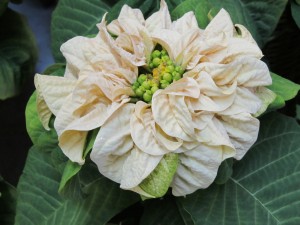Part IV. In mid-September bring plant indoors as outdoor temps start to drop below 50°F to initiate poinsettia flowering. Poinsettia is a “photoperiodic” plant, which means that floral buds and colorful bracts are initiated under short daylengths. A poinsettia requires 6 weeks of 10 hours or less of light per day.
You must be determined to stay with the photoperiodic schedule every day. Exposing a plant to just 1-2 hours more light on any day will keep the plant growing with no flower/bract response.
An alternative way of stating: keep your plant in complete darkness from 5 pm to 7 am for 40 days (6 weeks). Any momentary exposure to light will delay the bloom response. Move into a cardboard box or closet at dusk to block out the room light. Make certain that no direct light seeps in through the cracks.
By mid-November the upper leaves (bracts) should begin to color and flower buds form. Grow the plant at a sunny window and continue to water and fertilize.
Stop fertilizing around mid-December. Continue watering and enjoy your personally grown poinsettia over the holiday season.
Previous Blogs about Care of Poinsettias (dated: Dec. 18, 2010, Dec. 20, 2010, and Jan. 27, 2011)


 Posted in
Posted in 
